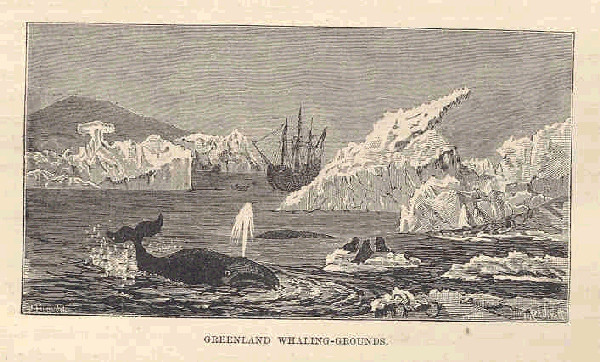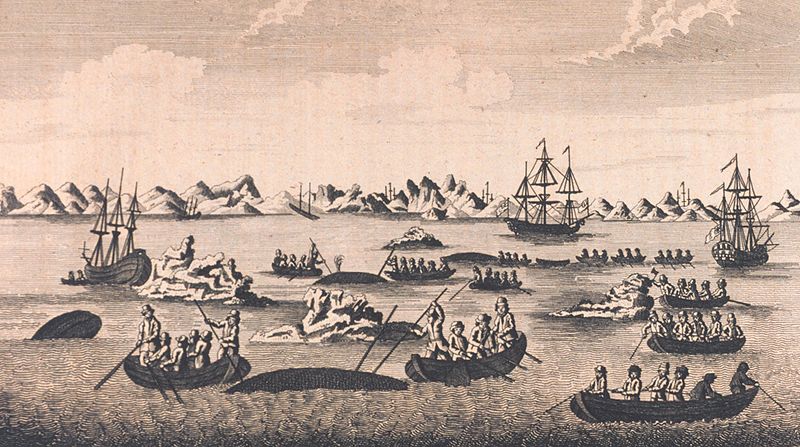Whaling in London
From Londonhua WIKI
Revision as of 15:53, 14 June 2017 by Mthatfalvi (talk | contribs)
Whaling in London
 Greenland Whaling | |
| Greenland Whaling | |
|---|---|
| Artist | Attributed to Frederick Whymper |
| Year | 1883 |
Overview
Whaling is a practice from back in the middle ages. In the 17th century, English whalers from the Greenland company started whaling.Overall, the whaling trade has periods of grown and decline. In the time of 1750, whale oil was used for street lighting, lubricating machinery, in pain,t and putty The whaling trade in London since the 1960's has closed due to other better sources of oil.
Contents
[hide]
Background
Begin writing the background information of this article, or use this format to begin a new article with some other relevant section filled with important information.
Beginning of Whaling
According to the London Waling Trade article on the London Port Cities website, the Middle Ages saw the start of the hunting of whales in the Bay of Biscay by Basque fishermen. [1] Then in the 17th century, English and Dutch whalers working for the Muscovy Company started searching in the Arctic for whales to trade with Russia.
Greenland Whaling
The Greenland Company took over the whaling side of the Muscovy Company because it was granted monopoly rights given by the government. London then had 20 whaling ships in the 1620s. During this whaling time though the English had bitter competition with the Dutch who eventually dominant them by mid 17th century.
Death of Whaling
In 1750, whale oil was being used for street lighting, machine lubricating in paint and putty. [1] Then the oil was replaced by gas and alternative oil sources. This brought the end to the big whaling industry in London and the last whale ship was sent out in 1835.
South Sea Whaling
Samuel Enderby, along with Alexander Champion and John St Barbe, fitted out twelve whaling ships for the southern fishery in 1776. More were sent in 1777 and 1778 before political and economic troubles hampered the trade for some time.[47] In 1786, Alexander Champion, with his brother Benjamin, sent the first British whaler east of the Cape of Good Hope. She was the Triumph, Daniel Coffin, master.
On 1 September 1788, the 270 ton whaleship Emilia, owned by Samuel Enderby & Sons and commanded by Captain James Shields, departed London. The ship went west around Cape Horn into the Pacific Ocean to become the first ship of any nation to conduct whaling operations in the Southern Ocean. A crewman, Archelus Hammond of Nantucket, killed the first sperm whale there off the coast of Chile on 3 March 1789. Emilia returned to London on 12 March 1790 with a cargo of 139 tons of whale oil.[48] The Enderby ship Friendship captained by Thomas Melvill was second collecting the 600 pounds.
In 1784 the British had fifteen whaleships in the southern fishery, all from London. By 1790 this port alone had sixty vessels employed in the trade. Between 1793 and 1799 there was an average of sixty vessels in the trade. The average increased to seventy-two in the years between 1800 and 1809.[49] The first sperm whale off the coast of New South Wales, Australia, was taken by the ship Britannia (Commander Thomas Melvill) in October 1791.[50]
In 1819 the first British whaleship, the Syren (510 tons), under Frederick Coffin of Nantucket, was sent to the Japan grounds, where she began whaling on 5 April 1820. She returned to London on 21 April 1822 with 346 tons of whale oil. The following year at least nine British whalers were cruising on this ground, and by 1825 the British had twenty-four vessels there.[51]
Despite this discovery, the number of vessels being fitted out annually for the southern fishery declined from sixty-eight in 1820 to thirty-one in 1824. In 1825 there were ninety ships in the southern fishery, but by 1835 it had dwindled to sixty-one.
Fewer and fewer vessels were being fitted out, so that by 1843 only nine vessels were clearing for the southern fishery. In 1859 the last cargoes of whale oil from British vessels were landed in London.
References
- ↑ Jump up to: 1.0 1.1 The London whaling trade. (n.d.). Retrieved May 23, 2017, from http://www.portcities.org.uk/london/server/show/ConNarrative.129/chapterId/2633/The-London-whaling-trade.html
External Links
PortCities London Whaling Trade
Image Gallery
If appropriate, add an image gallery
